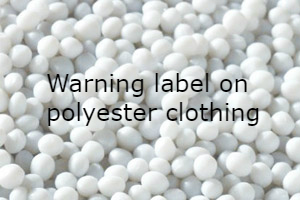
Connecticut could act on polyester apparel pollution
YarnsandFibers News Bureau 2018-04-17 12:16:00 – USAA bill is pending in California that would require a warning label on polyester clothing, alerting consumers that washing polyester contributes to microfiber pollution, and now the Connecticut legislature has taken up the issue.A bill posted to the State Senate calendar, after it passed out of a joint committee, aims to “establish a consumer awareness, education and clothing labeling program that is intended to reduce the amount of microfiber plastic in the state’s waterways†If passed, the bill would order the Commissioner of Energy and Environmental Protection, in consultation with the Commissioner of Consumer Protection, to convene a working group of representatives of the apparel industry and the environmental community to develop a consumer awareness and education program “concerning the presence of synthetic microfibers in clothingâ€
In testimony before the Environment Committee of the Connecticut General Assembly in March, Kristen Kern, government relations representative for the AAFA, said, “Another label or hangtag is not the solution. Garments already convey extensive information–per federal law–on matters of product safety, fiber content, care instructions, responsible party and country of origin. Further labeling in this case is redundant and would only be lost in the information that is already mandated. At best, customers would simply ignore it. At worst, it would cause confusion or harm if customers ended up caring for their garments in a way that damaged their clothing.†Kern said since federal care instructions require a provision on the best ways to avoid damage to the garment, a state-based care instruction that led to this outcome would conflict with federal law, and fail on federal preemption grounds
And, as Kern said that, “While data shows that microfibers exist as a source of contamination in waterways, there is a significant lack of data currently to indicate the exact sources and mechanisms of microfiber pollution. It is also important to note that there is no evidence that simply incorporating synthetic microfiber in a product automatically contributes to the microfiber shedding problem. â€Instead of a “regulatory outcome,†Kern suggested the legislature allow the apparel industry to continue studying the cause of microfiber pollution and what role the industry might be playing in causing this pollution, and to identify effective solutions, best practices and guidelines to limit any adverse impact.“While we agree that industry coalitions are an excellent way to address industry issues, and would expect to be involved in any working group that addresses this or any other issues, the [bill] tasks the working group with a prescribed regulatory outcome, rather than allowing the group to study microfiber pollution and decide on viable solutions to address it,†she added
The Ellen MacArthur Foundation’s 2016 report on the future of plastics estimated that the world’s oceans will contain more plastic than fish by 2050.The Hohenstein Institute is studing reducing the discharge of microplastics into wastewater, leading to harmful health effects on animals and humans. Hohenstein is applying proprietary technology and testing methods to thoroughly analyze microplastics in industrial laundry effluents. In addition to defining the state of the problem, the test will also explore the washing process for opportunities to minimize microplastics emissions. According to the bill, garments made from synthetic fibers such as polyester can shed up to 1,900 microfibers per wash. Since these fibers “are small enough to get past filters, they’re ending up in waterways and the ocean,†per a statement from bill sponsor, Assemblyman Richard Bloom (D., Santa Monica)
The program would include information explaining to consumers how microfibers are shed from clothing and dispersed in the state’s waterways, what best practices would be to eliminate and reduce the disbursement of those microfibers, plus information on apparel industry efforts to reduce or eliminate microfibers in clothing
The working group would include representative from the Sustainable Apparel Coalition, the Council of Fashion Designers of America,the American Apparel & Producer’s Network, Fashion Group International, National Retail Federation, American Apparel & Footwear Association and Fashion Business Inc
Market Intelligence
Ask for free sample Report

experience
Customer Base
dedicated team
Countries Served Worldwide









